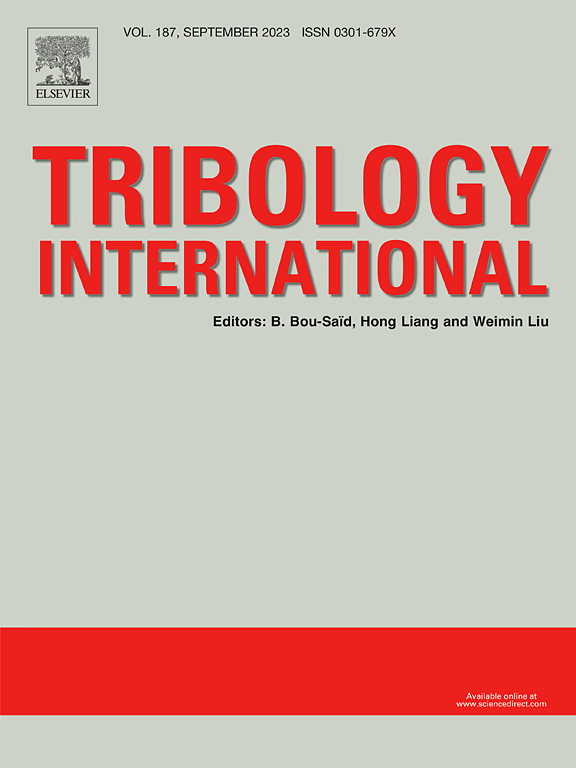石墨烯固液两相润滑系统摩擦学特性的分子动力学模拟和机器学习预测
IF 6.1
1区 工程技术
Q1 ENGINEERING, MECHANICAL
引用次数: 0
摘要
石墨烯与基础油之间的固液相互作用对润滑性能和机理的影响尚缺乏深入研究。本文充分考虑了接触压力、基础油链长差异和表面粗糙度特性,通过分子动力学模拟揭示了石墨烯油润滑系统在不同润滑条件下的摩擦学特性和润滑机理,并基于四种机器学习算法预测了摩擦磨损。结果表明,在流体润滑条件下,基础油链长和接触压力的增加会恶化润滑性能,其原因是长链基础油增强了固液界面的层间滑动阻力,并吸附在摩擦副表面形成较厚的类固态油膜,而高接触压力会引起润滑油粘度和内应力的增加。在边界润滑条件下,链条长度的增加改善了润滑,而接触压力则加剧了摩擦磨损。长链基础油增加了油膜厚度和强度,改善了石墨烯弯曲皱纹和润滑油流动性,并促进了润滑状态的转换。然而,高接触压力却呈现出相反的趋势,导致润滑性能恶化。此外,集合学习算法显示出最佳的摩擦(R2 =0.968)和磨损(R2 =0.951)预测能力。本文章由计算机程序翻译,如有差异,请以英文原文为准。
Molecular dynamics simulation and machine learning prediction of tribological properties of graphene solid-liquid two-phase lubrication system
The influence of solid-liquid interaction between graphene and base oil on lubrication performance and mechanism still lacks insight. This paper fully considered contact pressure, differences in base oil chain length, and surface roughness characteristics, the tribological properties and lubrication mechanism of graphene oil lubrication system under different lubrication regimes were revealed by molecular dynamics simulations, and frictional wear was predicted based on four machine learning algorithms. The results indicated that under fluid lubrication regimes, the increase in base oil chain length and contact pressure deteriorated lubrication performance, which was attributed to the long-chain base oils enhanced the interlayer sliding resistance at the solid-liquid interface and adsorbed on the friction pair surface to form a thicker solid-like film, while the high contact pressure induced an increase in lubricant viscosity and internal stress. Under boundary lubrication, increased chain length improved lubrication while contact pressure aggravated frictional wear. Attributed to long-chain base oils increased oil film thickness and strength, improved graphene bending wrinkles and lubricant fluidity, and facilitated lubrication state transitions. However, high contact pressure showed the opposite trend, resulting in worsening lubrication performance. Moreover, the ensemble learning algorithm exhibited optimal friction (R2 =0.968) and wear (R2 =0.951) prediction capabilities.
求助全文
通过发布文献求助,成功后即可免费获取论文全文。
去求助
来源期刊

Tribology International
工程技术-工程:机械
CiteScore
10.10
自引率
16.10%
发文量
627
审稿时长
35 days
期刊介绍:
Tribology is the science of rubbing surfaces and contributes to every facet of our everyday life, from live cell friction to engine lubrication and seismology. As such tribology is truly multidisciplinary and this extraordinary breadth of scientific interest is reflected in the scope of Tribology International.
Tribology International seeks to publish original research papers of the highest scientific quality to provide an archival resource for scientists from all backgrounds. Written contributions are invited reporting experimental and modelling studies both in established areas of tribology and emerging fields. Scientific topics include the physics or chemistry of tribo-surfaces, bio-tribology, surface engineering and materials, contact mechanics, nano-tribology, lubricants and hydrodynamic lubrication.
 求助内容:
求助内容: 应助结果提醒方式:
应助结果提醒方式:


